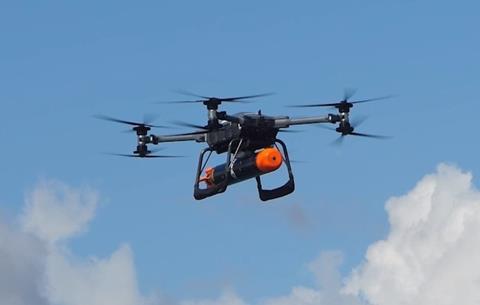Following its purchase by BAE Systems earlier this year, UK unmanned air vehicle (UAV) manufacturer Malloy Aeronautics is significantly boosting output and targeting continued growth.
Malloy chief executive Neil Appleton notes that the company’s production increased from around 12-15 platforms in 2021 to almost 200 last year, while it grew from roughly 30 employees to 90 today.
Current orders include a five-year commitment from the US Marine Corps to equip its units with the company’s T-150 quadcopter. With a range of around 7nm (13km) while carrying a maximum payload of 68kg (150lb), the type can perform roles including carrying blood supplies and ammunition.
Last September saw Malloy’s 275kg-payload T-600 take part in NATO’s REPMUS naval exercise in Portugal. This culminated with the electric-powered UAV dropping a 200kg BAE Sting Ray Mod 2 lightweight torpedo.

“That was a great demonstration of drones moving out of small things and carrying small payloads into some serious heavy kit,” Appleton says. “It was a huge success in starting to prove to customers that this kind of technology isn’t just for logistics: you can start to move other things around.”
Meanwhile, Malloy plans to launch flight testing later this year of a T-600 equipped with an interchangeable power system. This will enable it to switch between using batteries and hybrid propulsion, boosting operational flexibility.
Also last September, BAE exhibited a planned T-650-model aircraft – then being developed in partnership with pre-acquisition Malloy – adapted for casualty evacuation tasks.

“I believe that [battlefield] drones will be used to carry people whether we clear them or not,” Appleton says. “In extremis, a frontline commander is going to make a call that a drone may be the safest way of extracting a person.
“What is the balance of risk against sending a four-person, crewed helicopter into a contested environment? And is it a better option than [using] a ground vehicle, which could create more risk to more lives?”
Exploring the concept has included considering factors such as the level of ballistic protection, medical care provision and communication needs required for such a concept, he says.
Describing the REPMUS activity as a “stepping stone” towards providing an operational T-650, Appleton says: “we are still progressing with the concept”, but adds that there is no fixed target date to fly the new vehicle.
“Getting up to a drone which can carry 300kg requires a whole drivetrain development programme. Everything from the rotor backwards needs to be considered,” he says.
Such a product also must be easily manufactured and supported, he adds, noting: “As platforms start to get bigger, the last thing we need is a massive logistics chain for a logistics drone.”
Recent non-military product activities have included conducting cargo drone trials, respectively involving lifting a 100kg payload to the top of a wind turbine, and transferring oil samples from a rig to shore.
“Proving the capability can start to replace helicopters is job one, and it has been pretty effective,” Appleton says. “We are never going to replace helicopters in terms of tonnage or hours of endurance, but you can make a fleet of these drones be the workhorse… and save helicopters for when they are truly needed.”
He notes: “BAE isn’t restraining us in terms of going after the commercial sector.”
And Malloy also is currently working to boost its manufacturing resilience.
“We are doing an exercise to look at onshoring a number of components, to have a more robust supply chain,” he says. “We think we can get to the same price per motor as Chinese suppliers. We think we can get a better-quality product by investing in the equipment ourselves and starting to mass produce motors. It’s one area where we think we can genuinely start to compete.”































